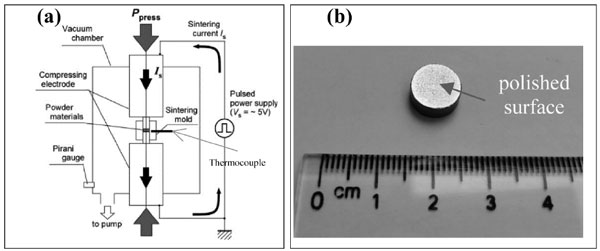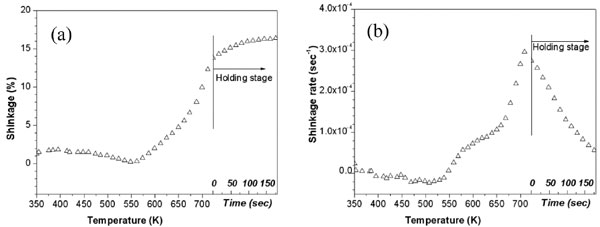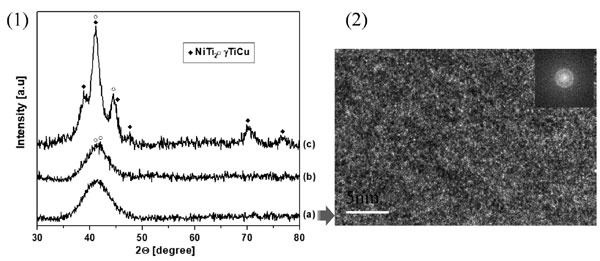In this work, the mechanically alloyed Ti50Cu32Ni15Sn3 amorphous powders were con- solidated by SPS technique. Microstructure, micro-hardness and sintering behavior of bulk samples were investigated…
Hợp kim vô định hình khối cơ sở Ti chế tạo bằng thiêu kết xung điện plasma
NGUYEN HOANG VIET*, NGUYEN THI HOANG OANH
Hanoi University of Science and Technology, Hanoi, Vietnam
*Email: viet.nguyenhoang@hust.edu.vn
Ngày nhận bài: 19/4/2019, Ngày duyệt đăng: 8/6/2019
ABSTRACT
Mechanically alloyed amorphous Ti50Cu32Ni15Sn3 powders were consolidated by spark plasma sintering, and their microstructure and hardness were investigated. At sintering temperature of 643 K, which was below the glass transition temperature, sample retained fully amorphous structure. At higher sintering temperature of 698 K, sam- ple was partly crystallized. An intermetallic gTiCu phase was formed in amorphous matrix. When the sintering tem- perature of 723 K was higher than onset temperature, the retained amorphous phase transferred partly to inter- metallic NiTi2 and gTiCu phases. The highest Vickers micro-hardness was about 786 HV obtained for sample sintered at 723 K.
Key words: Ti-based alloys, bulk amorphous alloy, spark plasma sintering.
TÓM TẮT
Bột hợp kim hóa cơ học vô định hình Ti50Cu32Ni15Sn3 được kết khối bằng thiêu kết xung điện plasma và nghiên cứu tổ chức tế vi và độ cứng của mẫu thiêu kết. Thiêu kết mẫu bột hợp kim tại nhiệt độ 643 K, ở dưới nhiệt độ chuyển pha thủy tinh, mẫu thiêu kết vẫn giữ được đầy đủ cấu trúc vô dịnh hình. Tại nhiệt độ thiêu kết cao hơn ở 698 K, mẫu đã bị tinh thể hóa một phần. Pha liên kim TiCu đã hình thành trên nền vô định hình. Khi thiêu kết ở nhiệt độ 723 K, nhiệt độ cao hơn điểm bắt đầu kết tinh, pha vô định hình còn dư đã chuyển biến một phần thành các pha liên kim NiTi2 và gTiCu. Độ cứng tế vi Vickers cao nhất của mẫu thiêu kết ở 723 K đạt được là 786 HV.
Từ khóa: hợp kim cơ sở Ti, hợp kim vô định hình khối, thiêu kết xung điện plasma.
1. INTRODUCTION
Ti-based bulk metallic glasses (BMG) are regarded as highly promising materials due to the combination of lightweight, outstanding mechani- cal properties and high corrosion resistance at room temperature [1, 2]. The tensile strength of bulk Ti50Ni25Cu25 amorphous alloys produced by mold casting is about 1800 MPa [3]. However, Ti- based bulk amorphous alloys produced by rapid quenching techniques required a high critical cooling rate to form amorphous phase. The largest diameter obtained for Ti-Ni-Cu-Sn bulk amorphous alloys was 5 mm [3] which limits their applications. For that reason, there have been some attempts to produce bulk amorphous alloys by powder metal- lurgical processing methods such as mechanical alloying (MA) subsequently consolidated by spark plasma sintering (SPS) [4-8]. MA is an effective and relatively simple method of producing amorphous alloy powders, which is suitable for com- paction and densification to various shapes [4, 5, 9]. SPS process involves the simultaneous appli- cation of a low voltage and a pulsed electric cur- rent under uniaxial pressure. The sintering is car- ried out at relatively low temperatures for a short- er time than in conventional sintering processes. The sample is heated by the Joule-heating and the sparking among the particles of sintered material leads to the faster heat and mass transfer instan- taneously. Therefore, the SPS process shows a large potential for achieving fast and full densifica- tion of amorphous powders [4, 5, 10].
In this work, the mechanically alloyed Ti50Cu32Ni15Sn3 amorphous powders were con- solidated by SPS technique. Microstructure, micro-hardness and sintering behavior of bulk samples were investigated.
2. EXPERIMENTAL
Amorphous alloy powder with nominal composition of Ti50Cu32Ni15Sn3 was synthesized via mechanical alloying at 300 rpm for 30 h as report- ed in [11] using a planetary ball mill AGO-II. As- milled powders were consolidated by SPS (using SPS-515 Sumitomo Coal Mining, Japan) at 643, 698 and 723 K with a heating rate of 10 K/min and holding for 3 min. Sintering experiments were carried on in vacuum environment around 4.0 × 10−3 Pa. During sintering process samples were put under an applied pressure of 500 MPa. Mold and punches with a diameter of 10 mm were made from tungsten to suffer a high load. The SPS configuration and sintered sample with a diameter of 10 mm are seen in Fig. 1 a. The phase analysis of sintered samples on the polished surface (Fig. 1 b) was realized by the XRD measurements with a RIGAKU RINT-2000 using CuKα (λ = 1.5405 Å) radiation. A high-resolution transmission electron microscope (Tecnai 20-EDS Phoenix) was used to observe the structure of the sample. The polished surface of sintered samples was observed by an Olympus PMG3 optical microscope (Olympus Corporation, Tokyo, Japan) with computerized image analysis. Density of sintered samples were evaluated according to Archimedes’ principle. Vickers microhardness measurements were per- formed on the polished surface of sintered samples using a Mitutoyo MVK-H1 hardness testing machine under a load of 100 g.

3. RESULT AND DISCUSSION
Optical micrographs of polished surface of Ti50Cu32Ni15Sn3 samples sintered at 643, 698 and 723 K under 500 MPa are shown in Fig. 2. At low sintering temperature of 643 K, porosities can be seen clearly in black color (Fig. 2a). At higher sin- tering temperature, the amount of porosities is reduced significantly (Fig. 2b). Sample obtained high density at highest sintering temperature of 723 K (Fig. 2c).

The curves of change in shrinkage and shrink- age rate of Ti50Cu32Ni15Sn3 alloy powder during the sintering process are showed in Fig. 3. The shrinkage process of sample starts at 520 K. Sample was shrunk about 14 % at sintering tem- perature of 723 K. The highest shrinkage rate of sample reaches maximum value at 710 K. Sample continues shrinking about 4 % in holding state.

The sintering temperature of 643 K may be corre- sponding to supercooled liquid region of Ti50Cu32Ni15Sn3 alloy. This temperature is likely lower than the glass transition and onset crystal- lization temperature, however there is a temperature difference between center and border of sample during SPS because the thermal couple was inserted at the edge of sample. So usually the real temperature in the center of sample is higher than that at its edge. Wang Yucheng el al. [12] studied the temperature difference between center and edge of sample, it is about 110 oC.

Fig. 4 (1) shows XRD patterns of samples sintered at different sintering temperatures. There are no crystalline peaks detected from XRD pattern under the resolution limit of XRD for sample sin- tered at 643K (Fig. 4(1)a). The combination of HRTEM and electron diffraction can provide useful information about nature of amorphous materials. Fig. 4(2) presents a highresolution transmission electron microscope (HRTEM) image and the corresponding selected area electron diffraction (SAED) pattern of the Ti50Cu32Ni15Sn3 alloy after sintering at 643 K for 3 min. The SAED shows a characteristic halo ring indicating the amorphous phase. For sample sintered at higher temperature of 698 K, an intermetallic of gTiCu was identified together with residual amorphous phase (Fig. 4(1)b). At 723 K, the amorphous phase partly transferred to gTiCu and NiTi2 intermetallic phases (Fig. 4(1)c). For the same sintering conditions as 723 K and 500 MPa for 3 min, however a little change in composition of Ti-Cu-Ni-Sn led to different crystallization phases: for Ti50Cu32Ni15Sn5 only intermetallic NiTi2 phase has been precipitat- ed in amorphous matrix [5].
Table 1. Vickers hardness, density values of Ti-Cu-Ni-Sn bulk samples
| Temperature(K) | Density(g/cm3) | Hardness(HV) |
| 643 | 5.66 | 675 |
| 698 | 5.72 | 784 |
| 723 | 5.80 | 786 |
The density and hardness values of sintered samples are given in table 1. Sample sintered at 643 K has an amorphous structure with a density value of only about 5.66 g/cm3. At higher sintering temperature the sample became denser and at 723 K showed the highest density and hardness. Also, the sample had a nano-composite structure with intermetallic NiTi2 and gTiCu phases embedded in amorphous matrix.
4. CONCLUSIONS
Bulk Ti50Cu32Ni15Sn3 amorphous alloys were produced by spark-plasma sintering from as-milled amorphous powders. Amorphous structure was retained for sample sintered at 643 K as confirmed from XRD and HR-TEM results. A small fraction of the intermetallic γTiCu phase was detected togeth- er with amorphous phase after sintering sample at 698 K. Nearly full crystallization of sample sintered at 723 K was obtained with intermetallic phases of NiTi2 and γTiCu. The density of the sintered sam- ples was 5.66÷5.80 g/cm3. The hardness of the bulk samples increased as the sintering temperature was increased from 643 to 723 K. The highest Vickers hardness value was 786 HV for sample sintered at 723 K.
ACKNOWLEDGMENTS
The authors would like to thank Prof. Ji-Soon Kim (University of Ulsan, Ulsan, South Korea) for raw materials and SPS facility.
REFERENCES
- Akihisa Inoue, Nobuyuki Nishiyama, Kenji Amiya, Tao Zhang, and Tsuyoshi Masumoto; Ti-based amorphous alloys with a wide supercooled liquid region, Materials Letters, 61(14), 2007, 2851-2854.
- Hiroaki Kishimura and Hitoshi Matsumoto; Fabrication of Ti-Cu-Ni-Al amorphous alloys by mechanical alloy- ing and mechanical milling, Journal of Alloys and Compounds, 509(12), 2011, 4386-4389.
- V. Louzguine and A. Inoue; Nanocrystallization of Ti-Ni-Cu-Sn amorphous alloy, Scripta Materialia, 43(4), 2000, 371-376.
- P. Choi, J. S. Kim, O. T. H. Nguyen, D. H. Kwon, Y. S. Kwon, and J. C. Kim; Al-La-Ni-Fe bulk metallic glasses produced by mechanical alloying and spark-plasma sintering, Materials Science and Engineering: A, 449- 451, 2007, 1119-1122.
- P. Choi, J. S. Kim, O. T. H. Nguyen, and Y. S. Kwon; Ti50Cu25Ni20Sn5bulk metallic glass fabricated by powder consolidation, Materials Letters, 61(23), 2007, 4591-4594.
- Suryanarayana and A. Inoue; Bulk Metallic Glasses, 2ndEdition ed: CRC Press, 2011.
- Nguyen Viet, T. Nguyen Oanh, Ji-Soon Kim, and M. Alberto Jorge; Crystallization Kinetics and Consolidation of Al82La10Fe4Ni4Glassy Alloy Powder by Spark Plasma Sintering, Metals, 8(10), 2018.
- Nguyen Hoang Viet, Nguyen Thi Hoang Oanh, Pham Ngoc Dieu Quynh, Tran Quoc Lap, and Kim Ji Soon; Bulk Amorphous Al80Fe20Produced by Mechanical Alloying and Spark-Plasma in The second International Conference on Advanced Materials and Nanotechnology (ICAMN2014), 2014.
- Nguyen Thi Hoang Oanh, Nguyen Hoang Viet, Dina Dudina, Alberto Moreira Jorge, and Ji-Soon Kim; Structural characterization and magnetic properties of Al82Fe16TM2(TM: Ti, Ni, Cu) alloys prepared by mechani- cal alloying, Journal of Non-Crystalline Solids, 468, 2017, 67-73.
- Sergio Scudino, Kumar Surreddi, Hoang V. Nguyen, Gang Liu, Thomas Gemming, Mira Sakaliyska, Ji S. Kim, Jens Vierke, Markus Wollgarten, and Jurgen Eckert; High-strength Al87Ni8La5 bulk alloy produced by spark plasma sintering of gas atomized powders, Journal of Materials Research, 24(9), 2011, 2909-2916.
- T. H. Oanh, Pyuck Pa Choi, Ji Soon Kim, Dae Hwan Kwon, and Young Soon Kwon; Thermal Stability of Amorphous Ti-Cu-Ni-Sn Prepared by Mechanical Alloying, Materials Science Forum, 534-536, 2007, 233-236.
- Wang Yucheng and Fu Zhengyi; Study of temperature field in spark plasma sintering, Materials Science and Engineering: B, 90(1), 2002, 34-37.
